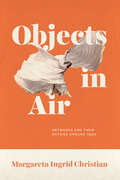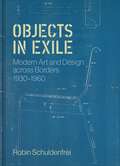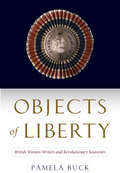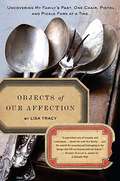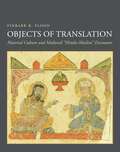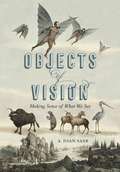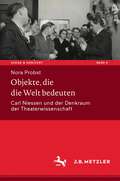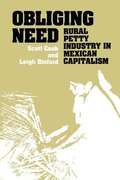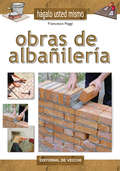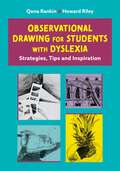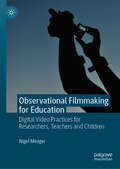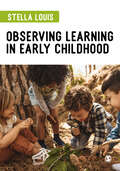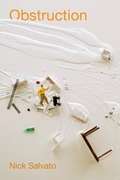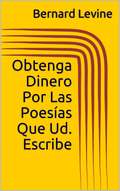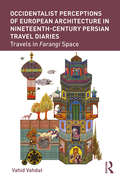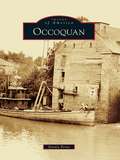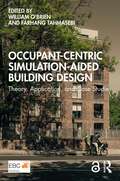- Table View
- List View
Objects in Air: Artworks and Their Outside around 1900
by Margareta Ingrid ChristianMargareta Ingrid Christian unpacks the ways in which, around 1900, art scholars, critics, and choreographers wrote about the artwork as an actual object in real time and space, surrounded and fluently connected to the viewer through the very air we breathe. Theorists such as Aby Warburg, Alois Riegl, Rainer Maria Rilke, and the choreographer Rudolf Laban drew on the science of their time to examine air as the material space surrounding an artwork, establishing its “milieu,” “atmosphere,” or “environment.” Christian explores how the artwork’s external space was seen to work as an aesthetic category in its own right, beginning with Rainer Maria Rilke’s observation that Rodin’s sculpture “exhales an atmosphere” and that Cezanne’s colors create “a calm, silken air” that pervades the empty rooms where the paintings are exhibited. Writers created an early theory of unbounded form that described what Christian calls an artwork’s ecstasis or its ability to stray outside its limits and engender its own space. Objects viewed in this perspective complicate the now-fashionable discourse of empathy aesthetics, the attention to self-projecting subjects, and the idea of the modernist self-contained artwork. For example, Christian invites us to historicize the immersive spatial installations and “environments” that have arisen since the 1960s and to consider their origins in turn-of-the-twentieth-century aesthetics. Throughout this beautifully written work, Christian offers ways for us to rethink entrenched narratives of aesthetics and modernism and to revisit alternatives.
Objects in Exile: Modern Art and Design across Borders, 1930–1960
by Robin SchuldenfreiAn essential examination of how emigration and resettlement defined modernismIn the fraught years leading up to World War II, many modern artists and architects emigrated from continental Europe to the United States and Britain. The experience of exile infused their modernist ideas with new urgency and forced them to use certain materials in place of others, modify existing works, and reconsider their approach to design itself. In Objects in Exile, Robin Schuldenfrei reveals how the process of migration was crucial to the development of modernism, charting how modern art and architecture was shaped by the need to constantly face—and transcend—the materiality of things.Taking readers from the prewar era to the 1960s, Schuldenfrei explores the objects these émigrés brought with them, what they left behind, and the new works they completed in exile. She argues that modernism could only coalesce with the abandonment of national borders in a process of emigration and resettlement, and brings to life the vibrant postwar period when avant-garde ideas came together and emerged as mainstream modernism. Examining works by Walter Gropius, László Moholy-Nagy, Lucia Moholy, Herbert Bayer, Anni and Josef Albers, and others, Schuldenfrei demonstrates the social impact of art objects produced in exile.Shedding critical light on how the pressures of dislocation irrevocably altered the course of modernism, Objects in Exile shows how artists and designers, forced into exile by circumstances beyond their control, changed in unexpected ways to meet the needs and contexts of an uncertain world.
Objects of Authority: A Postformalist Aesthetics (Routledge Research in Aesthetics)
by Jakub StejskalIs the celebrated elegance of Cycladic marble figurines an effect their Early Bronze Age producers intended? Can one adequately appreciate an Assyrian regal statue described by a cuneiform inscription as beautiful? What to make of the apparent aesthetic richness of the traditional cultures of Melanesia, which, however, engage in virtually no recognizable aesthetic discourse? Questions such as these have been formulated and discussed by scholars of remote cultures against the backdrop of a general scepticism about the prospects of escaping the conditioning of one’s own aesthetic culture and attuning to the norms of a remote one. This book makes a radical move: it treats the remote observers’ lack of aesthetic insight not as a hindrance to aesthetic analysis, but as a condition requiring an aesthetic theory that would make room for an aesthetic analysis independent of the model of competent aesthetic judgement or appreciation. Objects of Authority represents a rare effort at bringing together methods and concepts that are often addressed by separate disciplines. It will appeal to scholars and advanced students working on philosophical, art-historical, and anthropological theories of visual art and material culture.
Objects of Authority: A Postformalist Aesthetics (Routledge Research in Aesthetics)
by Jakub StejskalIs the celebrated elegance of Cycladic marble figurines an effect their Early Bronze Age producers intended? Can one adequately appreciate an Assyrian regal statue described by a cuneiform inscription as beautiful? What to make of the apparent aesthetic richness of the traditional cultures of Melanesia, which, however, engage in virtually no recognizable aesthetic discourse? Questions such as these have been formulated and discussed by scholars of remote cultures against the backdrop of a general scepticism about the prospects of escaping the conditioning of one’s own aesthetic culture and attuning to the norms of a remote one. This book makes a radical move: it treats the remote observers’ lack of aesthetic insight not as a hindrance to aesthetic analysis, but as a condition requiring an aesthetic theory that would make room for an aesthetic analysis independent of the model of competent aesthetic judgement or appreciation. Objects of Authority represents a rare effort at bringing together methods and concepts that are often addressed by separate disciplines. It will appeal to scholars and advanced students working on philosophical, art-historical, and anthropological theories of visual art and material culture.
Objects of Culture in the Literature of Imperial Spain
by Mary Barnard Frederick A. de ArmasCollecting and displaying finely crafted objects was a mark of character among the royals and aristocrats in Early Modern Spain: it ranked with extravagant hospitality as a sign of nobility and with virtue as a token of princely power. Objects of Culture in the Literature of Imperial Spain explores how the writers of the period shared the same impulse to collect, arrange, and display objects, though in imagined settings, as literary artefacts.These essays examine a variety of cultural objects described or alluded to in books from the Golden Age of Spanish literature, including clothing, paintings, tapestries, playing cards, monuments, materials of war, and even enchanted bronze heads. The contributors emphasize how literature preserved and transformed objects to endow them with new meaning for aesthetic, social, religious, and political purposes - whether to perpetuate certain habits of thought and belief, or to challenge accepted social and moral norms.
Objects of Liberty: British Women Writers and Revolutionary Souvenirs (EARLY MODERN FEMINISMS)
by Pamela BuckObjects of Liberty explores the prevalence of souvenirs in British women’s writing during the French Revolution and Napoleonic era. It argues that women writers employed the material and memorial object of the souvenir to circulate revolutionary ideas and engage in the masculine realm of political debate. While souvenir collecting was a standard practice of privileged men on the eighteenth-century Grand Tour, women began to partake in this endeavor as political events in France heightened interest in travel to the Continent. Looking at travel accounts by Helen Maria Williams, Mary Wollstonecraft, Catherine and Martha Wilmot, Charlotte Eaton, and Mary Shelley, this study reveals how they used souvenirs to affect political thought in Britain and contribute to conversations about individual and national identity. At a time when gendered beliefs precluded women from full citizenship, they used souvenirs to redefine themselves as legitimate political actors. Objects of Liberty is a story about the ways that women established political power and agency through material culture.
Objects of Our Affection: Uncovering My Family’s Past One Chair, Pistol, and Pickle Fork at a Time
by Lisa TracyTracy delves into the history of the furniture, china, jewelry, and other memorabilia inherited from five generations of her family, only to discover that these items bring her face-to-face with the people who had collected them. bw photos throughout.
Objects of Reflection: A Soulful Journey Through Assemblage
by Annie LockhartUse souvenirs, keepsakes and everyday objects in your own brand of storytelling. Objects of Reflection brings you a new form of visual journaling–that of assemblage–by creating art that is extremely personal and evokes your fondest memories. Inspiration pours from every page as author Annie Lockhart takes you on a journey inside of her own heart, sharing her stories for building pieces with tiny treasures and common objects. Specific elements of each project are displayed in a legend, detailing what each object symbolizes and will have you thinking about what similar objects might represent to you. In addition to providing insight on her own art-making process, Annie will guide you through her favorite step-by-step techniques for attaching elements with simple materials like string, wire and tape; aging objects to give them a bit of charm; adding texture with modeling paste and more. Dare to color outside the lines. Discover a new way to tell your own story and start using objects as "words" today. You'll also receive insight on valuable lessons such as: Quieting your harsh inner critic Seeing the beauty in objects that are broken Looking at the things you love with new perspective Realizing art need not be permanent to be enjoyed
Objects of Translation: Material Culture and Medieval "Hindu-Muslim" Encounter
by Finbarr FloodObjects of Translation offers a nuanced approach to the entanglements of medieval elites in the regions that today comprise Afghanistan, Pakistan, and north India. The book--which ranges in time from the early eighth to the early thirteenth centuries--challenges existing narratives that cast the period as one of enduring hostility between monolithic "Hindu" and "Muslim" cultures. These narratives of conflict have generally depended upon premodern texts for their understanding of the past. By contrast, this book considers the role of material culture and highlights how objects such as coins, dress, monuments, paintings, and sculptures mediated diverse modes of encounter during a critical but neglected period in South Asian history. The book explores modes of circulation--among them looting, gifting, and trade--through which artisans and artifacts traveled, remapping cultural boundaries usually imagined as stable and static. It analyzes the relationship between mobility and practices of cultural translation, and the role of both in the emergence of complex transcultural identities. Among the subjects discussed are the rendering of Arabic sacred texts in Sanskrit on Indian coins, the adoption of Turko-Persian dress by Buddhist rulers, the work of Indian stone masons in Afghanistan, and the incorporation of carvings from Hindu and Jain temples in early Indian mosques. Objects of Translation draws upon contemporary theories of cosmopolitanism and globalization to argue for radically new approaches to the cultural geography of premodern South Asia and the Islamic world.
Objects of Vision: Making Sense of What We See (Perspectives on Sensory History #3)
by A. Joan SaabAdvances in technology allow us to see the invisible: fetal heartbeats, seismic activity, cell mutations, virtual space. Yet in an age when experience is so intensely mediated by visual records, the centuries-old realization that knowledge gained through sight is inherently fallible takes on troubling new dimensions. This book considers the ways in which seeing, over time, has become the foundation for knowing (or at least for what we think we know). A. Joan Saab examines the scientific and socially constructed aspects of seeing in order to delineate a genealogy of visuality from the Renaissance to the present, demonstrating that what we see and how we see it are often historically situated and culturally constructed. Through a series of linked case studies that highlight moments of seeming disconnect between seeing and believing—hoaxes, miracles, spirit paintings, manipulated photographs, and holograms, to name just a few—she interrogates the relationship between "visions" and visuality. This focus on the strange and the wonderful in understanding changing notions of visions and visual culture is a compelling entry point into the increasingly urgent topic of technologically enhanced representations of reality.Accessibly written and thoroughly enlightening, Objects of Vision is a concise history of the connections between seeing and knowing that will appeal to students and teachers of visual studies and sensory, social, and cultural history.
Objects of Vision: Making Sense of What We See (Perspectives on Sensory History #3)
by A. Joan SaabAdvances in technology allow us to see the invisible: fetal heartbeats, seismic activity, cell mutations, virtual space. Yet in an age when experience is so intensely mediated by visual records, the centuries-old realization that knowledge gained through sight is inherently fallible takes on troubling new dimensions. This book considers the ways in which seeing, over time, has become the foundation for knowing (or at least for what we think we know). A. Joan Saab examines the scientific and socially constructed aspects of seeing in order to delineate a genealogy of visuality from the Renaissance to the present, demonstrating that what we see and how we see it are often historically situated and culturally constructed. Through a series of linked case studies that highlight moments of seeming disconnect between seeing and believing—hoaxes, miracles, spirit paintings, manipulated photographs, and holograms, to name just a few—she interrogates the relationship between “visions” and visuality. This focus on the strange and the wonderful in understanding changing notions of visions and visual culture is a compelling entry point into the increasingly urgent topic of technologically enhanced representations of reality.Accessibly written and thoroughly enlightening, Objects of Vision is a concise history of the connections between seeing and knowing that will appeal to students and teachers of visual studies and sensory, social, and cultural history.
Objekte, die die Welt bedeuten: Carl Niessen und der Denkraum der Theaterwissenschaft (Szene & Horizont. Theaterwissenschaftliche Studien #4)
by Nora ProbstDas Buch widmet sich in wissenschaftsgeschichtlicher Perspektive den Anfängen der Theaterwissenschaft in Köln. Es untersucht die Wissenschaftspraktiken des Kölner Institutsgründers Carl Niessen (1890–1969), der das Fach als Forscher, Dozent, Sammler und Kurator über einen Zeitraum von rund 40 Jahren geprägt hat. Besonderes Augenmerk legt diese erste wissenschaftsgeschichtliche Monografie über Niessen auf dessen erweitertes Theaterverständnis, das den Bogen von rituellen Handlungen und cultural performances bis hin zu den Phänomenen des europäischen Gegenwartstheaters spannte. – Ausgangspunkt der Studie ist das Gebäude des im Zweiten Weltkrieg zerstörten Theatermuseums am Salierring in Köln. Durch das virtuelle Abschreiten der Museumsräume werden die durch Niessen initiierten Praktiken der frühen Theaterforschung und -lehre kartografiert und vor dem Hintergrund der Fachentwicklung analysiert.
Obliging Need: Rural Petty Industry in Mexican Capitalism
by Leigh Binford Scott CookFor centuries throughout large portions of the globe, petty agriculturalists and industrialists have set their physical and mental energies to work producing products for direct consumption by their households and for exchange. This twofold household reproduction strategy, according to both Marxist and neoclassical approaches to development, should have disappeared from the global economy as labor was transformed into a producer as well as a consumer of capitalist commodities. But in fact, during the twentieth century, only the United States and Britain seem to have approximated this predicted scenario. Tens of millions of households in contemporary Asia, Africa, and Latin America and millions more in industrialized capitalist economies support themselves through petty commodity production alone or in combination with petty industry wage labor. Obliging Need provides a detailed and comprehensive analysis of small-scale peasant and artisan enterprise in the Oaxaca Valley of Mexico. The authors show how commodity production is organized and operates in different craft industries, as well as the ways in which it combines with other activities such as household chores, agriculture, wage labor, and petty commerce. They demonstrate how--contrary to developmentalist dogma--small-scale capitalism develops from within Mexico's rural economy. These findings will be important for everyone concerned with improving the lives and economic opportunities of countryfolk in the Third World. As the authors make clear, political mobilization in rural Mexico will succeed only as it addresses the direct producers' multiple needs for land, credit, more jobs, health insurance, and, most importantly, more equitable remuneration for their labor and greater rewards for their enterprise. For centuries throughout large portions of the globe, petty agriculturalists and industrialists have set their physical and mental energies to work producing products for direct consumption by their households and for exchange. This twofold household reproduction strategy, according to both Marxist and neoclassical approaches to development, should have disappeared from the global economy as labor was transformed into a producer as well as a consumer of capitalist commodities. But in fact, during the twentieth century, only the United States and Britain seem to have approximated this predicted scenario. Tens of millions of households in contemporary Asia, Africa, and Latin America and millions more in industrialized capitalist economies support themselves through petty commodity production alone or in combination with petty industry wage labor. Obliging Need provides a detailed and comprehensive analysis of small-scale peasant and artisan enterprise in the Oaxaca Valley of Mexico. The authors show how commodity production is organized and operates in different craft industries, as well as the ways in which it combines with other activities such as household chores, agriculture, wage labor, and petty commerce. They demonstrate how--contrary to developmentalist dogma--small-scale capitalism develops from within Mexico's rural economy. These findings will be important for everyone concerned with improving the lives and economic opportunities of countryfolk in the Third World. As the authors make clear, political mobilization in rural Mexico will succeed only as it addresses the direct producers' multiple needs for land, credit, more jobs, health insurance, and, most importantly, more equitable remuneration for their labor and greater rewards for their enterprise.
Obras de albañilería
by Francesco Poggi* Realizar en casa algunas obras de albañilería puede resultar fácil y divertido pero también, a veces, necesario: basta con seguir las instrucciones que se facilitan en este libro para que no encuentre ninguna dificultad en cualquier intervención que tenga que realizar. * Aprenderá todo sobre herramientas manuales y eléctricas, los distintos tipos de tacos y cómo utilizarlos, morteros de cal y cemento, muros, paredes divisorias, pavimentaciones externas, etc. * Una obra con la que aprenderá a construir con sus propias manos mesas, bancos, maceteros, barbacoas...
Obscenity and Film Censorship
by Bernard WilliamsWhen it first appeared in 1979, the Williams Report on Obscenity and Film Censorship provoked strong reactions. The practical issues and political principles examined are of continuing interest and remain a crucial point of reference for discussions on obscenity and censorship. Presented in a fresh series livery for the twenty-first century, and with a specially commissioned preface written by Onora O'Neill, illuminating its continuing importance and relevance to philosophical enquiry, this abridged edition of Bernard Williams's Report presents all the main findings and arguments of the full report, central to which is the application of Mill's 'harm principle' and the conclusion that restrictions are out of place where no harm can be reasonably thought to be done.
Observational Drawing for Students with Dyslexia: Strategies, Tips and Inspiration
by Qona Rankin Howard RileyThis hands-on practical guide provides dyslexic young people with techniques to improve their observational drawing skills, showing them how they can work around the issues commonly reported by students with SLDs. Many creative and talented individuals with neurological differences report difficulties with short-term memory, co-ordination and planning ahead within a project, and a lack of specialised teaching may even dissuade them from pursuing art at school. This book addresses those challenges.The authors, who have many years' experience of teaching art to dyslexic and dyspraxic students, also include examples not just of the techniques described, but also of the creative ideas other neurodiverse students have come up with. Fully illustrated, with clear explanations, and space to draw and sketch, this much needed book will provide dyslexic art students with the tools and confidence to achieve their goals and become the creative professionals of the future.
Observational Filmmaking for Education: Digital Video Practices for Researchers, Teachers and Children (Creativity, Education and the Arts)
by Nigel MeagerThis book places observational filmmaking in the context of the rapidly developing landscape of creativity and arts based research in education. The author uses observational filmmaking as a lens to address debates surrounding video based and arts based research. Utilising the work of Dewey and Deleuze as the theoretical underpinnings of the volume, this is combined with numerous practical examples of observational filmmaking in schools. The author argues that observational video camera and editing techniques combine careful observation with rigorous visual analysis: they place sensory, affectual and aesthetic qualities in experience centre stage. While observational filmmaking in itself has enormous potential as a methodology for education research, it may also become a fulcrum for children’s learning. Children record their experiences in the world around them as they look carefully with a video camera. This pioneering yet practical book will be of interest and value to students and scholars of creativity, learning, and education research methods, as well as constituting a useful guide for teachers, arts practitioners and education policy makers.
Observing Learning in Early Childhood
by Stella LouisThis book is a concise and accessible guide to observation as a tool for supporting learning for children aged 0 - 5. It provides comprehensive coverage of the what, why, and how of observation, brought to life with extensive case studies and contextualised alongside other crucial Early Years’ topics, including child development and play. This book encourages readers to consider their own context and practice, with reflective questions at the end of each chapter and specific chapters on linking observations to the curriculum and sharing insights with parents and colleagues. The focus on both learning and self-reflection makes ‘Observing Learning in Early Childhood’ ideal for students, newly qualified teachers, and current practitioners alike. Dr. Stella Louis is a freelance early years consultant, with 34 years’ experience of working with children and families across the UK, South Africa and Australia.
Observing Learning in Early Childhood
by Stella LouisThis book is a concise and accessible guide to observation as a tool for supporting learning for children aged 0 - 5. It provides comprehensive coverage of the what, why, and how of observation, brought to life with extensive case studies and contextualised alongside other crucial Early Years’ topics, including child development and play. This book encourages readers to consider their own context and practice, with reflective questions at the end of each chapter and specific chapters on linking observations to the curriculum and sharing insights with parents and colleagues. The focus on both learning and self-reflection makes ‘Observing Learning in Early Childhood’ ideal for students, newly qualified teachers, and current practitioners alike. Dr. Stella Louis is a freelance early years consultant, with 34 years’ experience of working with children and families across the UK, South Africa and Australia.
Obstruction
by Nick SalvatoCan a bout of laziness or a digressive spell actually open up paths to creativity and unexpected insights? In Obstruction Nick Salvato suggests that for those engaged in scholarly pursuits laziness, digressiveness, and related experiences can be paradoxically generative. Rather than being dismissed as hindrances, these obstructions are to be embraced, clung to, and reoriented. Analyzing an eclectic range of texts and figures, from the Greek Cynics and Denis Diderot to Dean Martin and the Web series Drunk History, Salvato finds value in five obstructions: embarrassment, laziness, slowness, cynicism, and digressiveness. Whether listening to Tori Amos's music as a way to think about embarrassment, linking the MTV series Daria to using cynicism to negotiate higher education's corporatized climate, or examining the affect of slowness in Kelly Reichardt's films, Salvato expands our conceptions of each obstruction and shows ways to transform them into useful provocations. With a unique, literary, and self-reflexive voice, Salvato demonstrates the importance of these debased obstructions and shows how they may support alternative modes of intellectual activity. In doing so, he impels us to rethink the very meanings of thinking, work, and value.
Obtenga Dinero Por Las Poesías Que Ud. Escribe
by Azul Lima Alessi Bernard Levine¿Escribes poesía? Ahora, puedes ganar dinero por la poesía que escribes y lograr publicarlas en tarjetas de felicitación, calendarios, pósters y placas de pared. Si quieres que tus sueños de escritor se hagan realidad y ganar dinero por tus poesías, este libro único es especialmente para Ud. ¡Escribir poemas por dinero es muy divertido y lucrativo! Gane dinero por hacer algo que ama.
Ocala
by Kevin M. Mccarthy Ernest JerniganNearly five centuries have passed since Ponce de Leon claimed for the king of Spain the area that now contains Ocala, the seat of Marion County in North Central Florida. Located midway between the Atlantic Ocean and the Gulf of Mexico, Ocala was incorporated in 1885, when it was home to just 803 inhabitants, and has grown steadily since that time. At the turn of the twentieth century, the city covered four square miles and had a population of 3,380, making Ocala the seventh largest town in Florida. From its Native American heritage, which includes important episodes in the life of Seminole leader Osceola, to its natural beauty featured in such places as the Ocala National Forest and the world-famous Silver Springs, Ocala has had a rich and fascinating past. Widely known today as champion thoroughbred horse country, Ocala and its environs also boast neighborhoods of well-preserved Victorian homes and other historic structures, a thriving business community, and a diverse populace that is dedicated to the constant improvement of this singular city. In 1995, Ocala was honored with the designation of "All America City" by the National Civic League. Paying tribute to this one-of-a-kind city, its residents--both past and present--and the story it has to tell, this volume of more than 200 vintage images showcases Ocala's rich historical legacy and the men and women who made it all possible.
Occidentalist Perceptions of European Architecture in Nineteenth-Century Persian Travel Diaries: Travels in Farangi Space
by Vahid VahdatIn the midst of Europe’s nineteenth-century industrial revolution, four men embarked on separate journeys to the wondrous Farangestan – a land of fascinating objects, mysterious technologies, heavenly women, and magical spaces. Determined to learn the secret of Farangestan’s advancements, the travelers kept detailed records of their observations. These diaries mapped an aspirational path to progress for curious Iranian audiences who were eager to change the course of history. Two hundred years later, Travels in Farangi Space unpacks these writings to reveal a challenging new interpretation of Iran’s experience of modernity. This book opens the Persian travelers’ long-forgotten suitcases, and analyzes the descriptions contained within to gain insight into Occidentalist perspectives on modern Europe. By carefully tracing the physical and mental journeys of these travelers, the book paints a picture of European architecture that is nothing like what one would expect.
Occoquan
by Earnie PortaAlthough Native Americans have lived along the banks of the Occoquan for thousands of years, John Smith was the first European to visit the area, arriving at the river's mouth in 1608. Here he encountered the Dogue Indians, from whose language the river and town take their names. With the coming of settlers, Occoquan's location at the meeting of the Tidewater and Piedmont made it ideal for water-related industry and commerce. By the end of the 18th century, it boasted one of the first automated gristmills in the nation. During the Civil War, Occoquan housed both Union and Confederate troops and was the sight of several small engagements. In 1972, the river, which had provided so many commercial and recreational benefits, revealed a more dangerous side as flooding from Hurricane Agnes caused severe damage. The people of Occoquan rebuilt, and the town evolved into the wonderful mixture of old and new that gives it the unique character seen today.
Occupant-Centric Simulation-Aided Building Design: Theory, Application, and Case Studies
by William O’Brien Farhang TahmasebiOccupant-Centric Simulation-Aided Building Design promotes occupants as a focal point for the design process. This resource for established and emerging building designers and researchers provides theoretical and practical means to restore occupants and their needs to the heart of the design process. Helmed by leaders of the International Energy Agency Annex 79, this edited volume features contributions from a multi-disciplinary, globally recognized team of scholars and practitioners. Chapters on the indoor environment and human factors introduce the principles of occupant-centric design while chapters on selecting and applying models provide a thorough grounding in simulation-aided building design practice. A final chapter assembling detailed case studies puts the lessons of the preceding chapters into real-world context. In fulfillment of the International Energy Agency’s mission of disseminating research on secure and sustainable energy to all, Occupant-Centric Simulation-Aided Building Design is available as an Open Access Gold title. With a balance of fundamentals and design process guidelines, Occupant-Centric Simulation-Aided Building Design reorients the building design community toward buildings that recognize and serve diverse occupant needs, while aiming for superior environmental performance, based on the latest science and methods.
